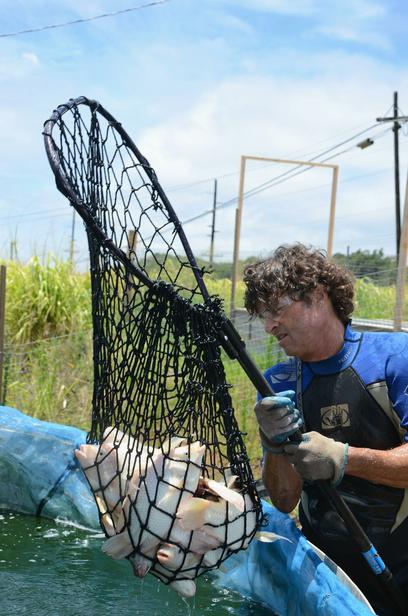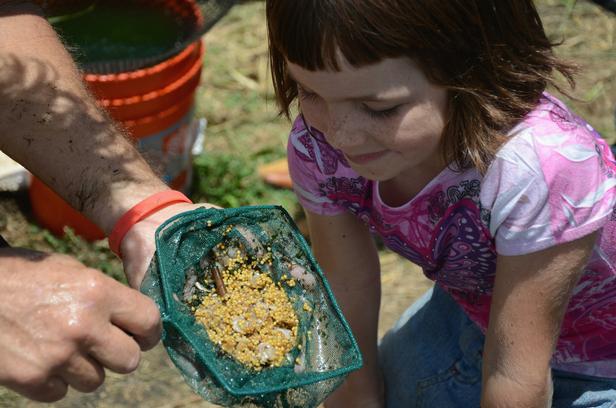Your own tilapia breeding operation is easy AND economical to build and operate with our new manual
You can supply all your fingerlings and fry from your tilapia breeding operation, plus have an additional income stream from selling fry and fingerlings to others.
Here’s a short video about how a tilapia breeding tank is set up.
How Does A Tilapia Hatchery Benefit You?
We operate an aquaponic farm raising both fish and vegetables, and have been teaching people how to do this for eight years now. The biggest barrier we’ve seen people deal with is often the difficulty and/or cost in procuring baby tilapia (or any fish!) to start their aquaponics system with.
Click here to purchase the Tilapia Breeding Manual ($98.95)
We regularly hear of people who’ve built our backyard “Micro System” then had to drive 8 hours each way across a couple of states to buy a bucket of two hundred 1-inch long baby tilapia for a dollar each. With aquaponics gaining in popularity every day, this is a huge market for the prospective hatchery operator that has just barely been tapped.
To see why our tilapia breeding technology works so well, watch this video (plus we’ll explain in just a bit):
Month-old tilapia fry (out-of-focus hand in glove on right for scale)
This tilapia hatchery manual includes complete text and photos, and is designed with the intention of empowering people with no previous hatchery experience to be able to run a commercial scale tilapia hatchery. It contains all the tricks and labor-saving shortcuts we’ve learned in five years of hatchery development.
In keeping with our policy of providing useful free information whenever we can afford to, you will find free information in our newsletter # 99 and our newsletter #100 that will teach you the basics of tilapia breeding. With this free information, you can set up a backyard or small commercial hatchery operation that will fill most people’s needs.
Click here to purchase the Tilapia Breeding Manual ($98.95)
Stressing the tilapia to make them “spit” their eggs
However, if you want the complete story in 66 pages, with highly descriptive photos of the process and equipment we use, this manual is ready for you. There’s even a “micro-video” that my gorgeous biologist wife Susanne shot with her treasured Leica Microscope that explains why the techniques we use work so well.
Although we’re not a big, well-funded university, we still do world-class research on aquaponics and tilapia aquaculture, and keep coming up with better ways for you to save money or make money with aquaponics and aquaculture, such as this hatchery technology.
Why is our hatchery technology such a big deal? We had an attendee at one of our 2011 Commercial Aquaponics Trainings who was a partner in a large tilapia hatchery in an East Asian country. He said that, although they hatched and sold millions of tilapia fry a year, the standard hatchery technology they used resulted in only a 25% survival rate of fry from tilapia eggs (which means they had a 75% mortality rate).
The explanation for this turns out to be really simple: these guys were hatching their tilapia into clear (not green!) water, where there was no food for the little fish to eat in the time after they absorbed their yolk sacs, but before they’d learned how to eat (the 75% they lost had simply starved to death!). Yes, tilapia feeding is a learned activity, and it takes the little ones from 7 to 10 days after they’ve absorbed their yolk sacs for the fish to learn how to eat. The video on this page explains, at a microscopic level, why our fry have a 95% or better survival rate.
When this man saw our simple system and heard about our 95% survival rate on tilapia eggs, his request was: “Don’t teach this to any of our country’s hatchery operators until we get it working first”. We said “sorry”, because we are honor bound to teach it to anyone who comes to one of our courses. We don’t hold things back to make more money off them later as consultants. This is the commercial level technology that’s included in the new hatchery manual, and it is a big deal; it means four times the production for these guys at the same cost.
The kicker: When we investigated costs for standard tilapia hatcheries from companies who supply this technology, we got estimated prices of $150,000 from a Thailand firm, $240-$440,000 from a Dutch firm, and a $350,000 estimate from a Swiss company. When we scaled a system (using our technology) for the same level of production the sellers of these store-bought systems claimed, we found it only cost about $35,000 for all the equipment and materials. This is pretty much the same problem we find with the aquaponics system “kit” sellers: there’s nothing special about their collections of tanks, pumps, and valves, except the fact that they’re marked up from 300 to 500 percent.
Click here to purchase the Tilapia Breeding Manual ($98.95)
This package also includes (at no additional cost), our $49.99 Fiberglass/Epoxy/Plywood DIY tank manual. If you are so inclined, you’ll have the information you need to fabricate custom fish tanks and other tanks yourself, from locally available and relatively inexpensive materials, using some basic woodworking skills and tools.
Dad and Rose checking out about 2,000 newly-harvested tilapia eggs; they go into a specially-plumbed McDonald Jar next
When you purchase the tilapia breeding manual, you will also receive, as a download, several supporting files, including that exclusive microscopic video Susanne shot that is crucial to understanding the tilapia biology explained in the manual.
Can’t find an affordable place to buy tilapia fry or fingerlings? Want to be part of the growing aquaponics community? Grow your own and sell them too, with your own economical tilapia breeding operation!
Make sure to check with your State’s Fish and Wildlife Department to determine if tilapia are LEGAL in your state: they are illegal to possess or raise in some states!
Click here to purchase the Tilapia Breeding Manual ($98.95)
Please Note: this product is an Electronic Manual: it is a download only, not a printed, mailed product. The order page DOES need your mailing address information, however, or it will generate an error message).